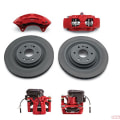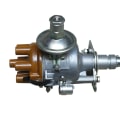For any car enthusiast, the thrill of a Triumph TR is undeniable. With its powerful acceleration and speed specs, the Triumph TR is an impressive vehicle to behold. But before you take it out on the road, you need to understand what those specs mean. In this article, we'll explain the acceleration and speed specs of the Triumph TR, how to interpret them, and how they can help you get the most out of your vehicle.
Acceleration and speed specs
are two important measures of a car's performance.Acceleration is the rate of change in speed over time, and it's usually measured in feet per second squared (FPS2). Speed, on the other hand, is the amount of distance covered over a specific period of time, and it's usually measured in miles per hour (MPH). To measure acceleration and speed specs accurately, drivers should use a vehicle dynamics tester, which measures the car's acceleration and speed at different points in time, allowing drivers to compare the different speeds and accelerations of the vehicle over different distances. When considering acceleration and speed specs for a car, it's important to look at how much acceleration a car has in relation to its weight. A heavier car will require more power to accelerate, while a lighter car will accelerate faster with less power. Acceleration is the rate of change in speed over time, and it's usually measured in feet per second squared (FPS2). Speed, on the other hand, is the amount of distance covered over a specific period of time, and it's usually measured in miles per hour (MPH). To measure acceleration and speed specs accurately, drivers should use a vehicle dynamics tester, which measures the car's acceleration and speed at different points in time, allowing drivers to compare the different speeds and accelerations of the vehicle over different distances. When considering acceleration and speed specs for a car, it's important to look at how much acceleration a car has in relation to its weight. A heavier car will require more power to accelerate, while a lighter car will accelerate faster with less power.
Additionally, the type of engine is also important; a higher-powered engine will accelerate faster than a lower-powered engine. Different models of cars also have different acceleration and speed specs, so it's important to compare them when choosing a car. The acceleration and speed specs of a car are important for determining its performance. A car with higher acceleration and speed specs will be able to reach higher speeds more quickly, giving it an advantage over other cars. Additionally, higher acceleration and speed specs will also allow the car to corner more sharply, giving it better handling capabilities. The Triumph TR is a popular model of car that is known for its performance.
The Triumph TR has an impressive set of acceleration and speed specs that make it one of the most powerful cars on the road. Its 0-60 time is only 4.7 seconds, which is impressive for a vehicle of its size and weight. It also has impressive cornering capabilities, thanks to its high-powered engine and well-designed suspension system. When compared to other cars, the Triumph TR stands out for its acceleration and speed specs. While other cars may have similar 0-60 times or cornering capabilities, the Triumph TR is able to reach higher speeds more quickly due to its higher power output and well-engineered suspension system.
Additionally, the Triumph TR's engine is designed for maximum power output, allowing it to accelerate faster than other cars. Drivers looking to maximize the performance of their Triumph TR should take advantage of its acceleration and speed specs. By understanding how the car's acceleration and speed specs affect its performance, drivers can adjust their driving style to get the most out of their car. Additionally, drivers should take the time to familiarize themselves with their car's specifications and adjust their driving style accordingly. This will help them get the most out of their Triumph TR.
What Are Acceleration and Speed Specs?
Acceleration and speed specs are measurements used to determine the performance of a vehicle, such as the Triumph TR.These specs are used to calculate the time it takes for the vehicle to accelerate or reach a certain speed, and can be used to compare different models of the same make and model. To measure acceleration and speed specs, acceleration tests are conducted in a controlled environment. The test measures how quickly the car accelerates from 0-60 miles per hour, or how quickly it can reach its top speed. The results of these tests are then used to calculate the acceleration and speed specs for the vehicle.
Acceleration and speed specs are important because they provide drivers with an indication of how well a car performs. They can also be used to compare different vehicles, which can be helpful when making a purchasing decision. Additionally, these specs can help identify potential problems with a vehicle's engine or transmission, which could lead to costly repairs.
Maximizing Performance with Acceleration and Speed Specs
Maximizing Performance with Acceleration and Speed SpecsWhen it comes to maximizing performance with the Triumph TR, acceleration and speed specs are key.Acceleration is the measure of how quickly a vehicle can accelerate from zero to sixty miles per hour. Speed, on the other hand, is the measure of how fast a car can travel at a given speed. Knowing how to measure and interpret acceleration and speed specs can help you make the most of your Triumph TR's performance. To maximize performance, you'll want to look for a Triumph TR that has a high acceleration rate.
This can be measured by the 0-60 mph time, which is the amount of time it takes for the car to reach a speed of 60 mph from a standstill. The faster the time, the better the acceleration. You should also look for a Triumph TR with a high top speed. This is usually measured by its maximum speed in kilometers per hour or miles per hour.
It's also important to understand how the car's aerodynamics affect its performance. The aerodynamics of a car affects how much air resistance it has, which in turn affects its acceleration and speed. A car with good aerodynamics will be able to accelerate faster and reach higher speeds than one with poor aerodynamics. Finally, you'll want to make sure that your Triumph TR has good traction control.
This is an important feature that helps keep your car from spinning out when accelerating quickly or taking sharp turns. Good traction control helps keep your car stable and gives you greater control over its performance.
How Do Acceleration and Speed Specs Affect the Performance of the Triumph TR?
Acceleration and speed specs are important considerations for the performance of the Triumph TR. Acceleration is a measure of how quickly the car can accelerate from a standing start, while speed is a measure of how quickly it can reach its top speed. The acceleration and speed specs of the Triumph TR can affect its performance in several ways. For instance, a car with higher acceleration specs will be able to accelerate faster, which can be beneficial in competitive driving situations.On the other hand, a car with higher speed specs will be able to reach higher top speeds, which can be beneficial for long-distance driving. In addition, acceleration and speed specs can also affect the car’s handling and fuel efficiency. A car with higher acceleration specs will generally have better handling, while a car with higher speed specs will tend to be more fuel efficient. Overall, understanding the acceleration and speed specs of the Triumph TR is essential in order to determine its performance capabilities.
By understanding these specs, drivers can make informed decisions about which features are best suited for their needs. Understanding the acceleration and speed specs of the Triumph TR is critical to getting the most out of its performance. Acceleration and speed specs can help drivers maximize the performance of their car by allowing them to take advantage of its capabilities. Knowing how to measure these specs and what they mean for the Triumph TR can help drivers make the most of their vehicles. In summary, understanding acceleration and speed specs is essential for drivers who want to get the most out of their Triumph TR's performance. By taking advantage of these specs, drivers can maximize their car's performance and get the most out of their driving experience.

